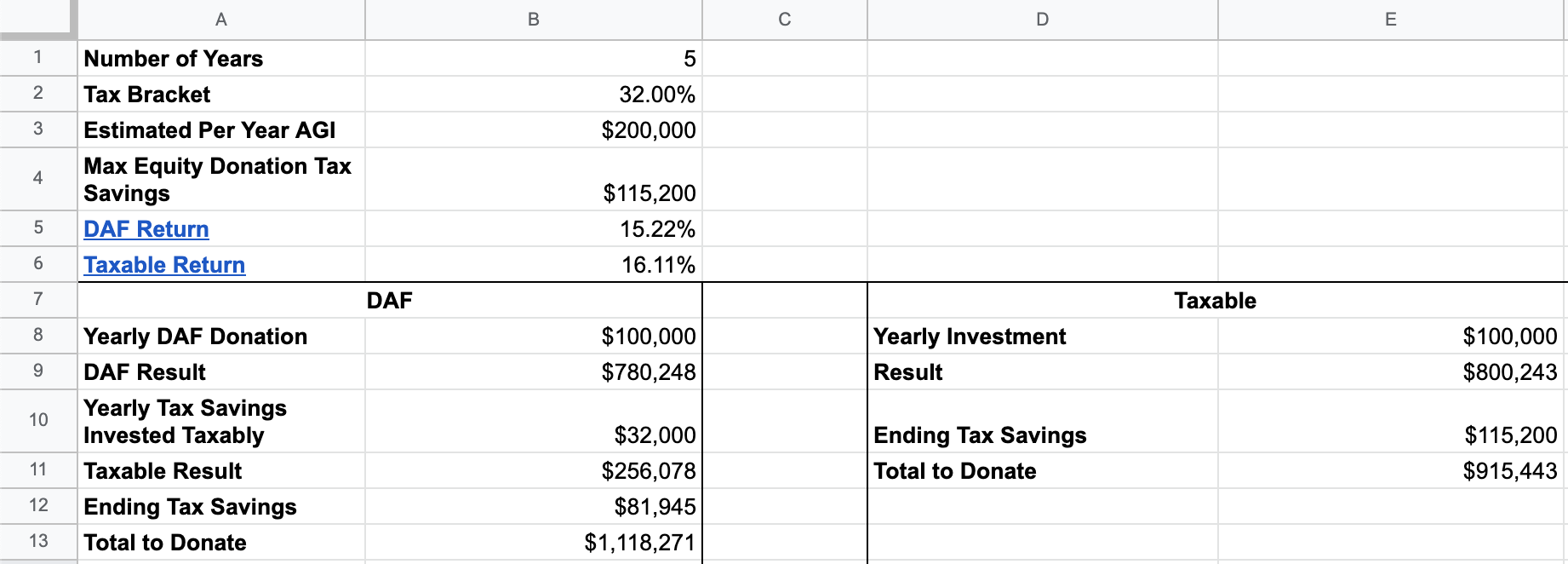I'd like to invest some money to donate in 3 - 5 years after I've had more time to solidify my cause prioritization. I've been considering whether to donate the money now to a donor advised fund (DAF) and let it appreciate there before disbursing to nonprofits later or to invest it in a taxable investment account and donate the appreciated investments later.
I've always heard that taxable accounts tend to win over DAFs because DAFs take an additional yearly percentage as admin fees from your balance (e.g. 0.6%) and so earn less. But DAFs also let you take the tax deduction sooner whenever you contribute to one. I decided to put together a spreadsheet to see in what scenario a DAF might come out ahead.
The approach I found that resulted in the most money to donate in the end is a hybrid approach of donating yearly to a DAF, then investing the tax savings from the DAF donation in a taxable investment account. When ready to disburse money to a nonprofit, you disburse the appreciated funds from the DAF, donate the appreciated assets in the taxable investment account, and finally also donate the tax savings from donating the taxable investments.
I modeled this in a spreadsheet based on the following:
- Yearly adjusted gross income of $200,000.
- Yearly DAF contribution of $100,000.
- US tax bracket of 32%.
- Taxable investment return of 16.11% (10 year average return of the Vanguard S&P 500 ETF VOO minus its 0.03% expense ratio).
- DAF investment return of 15.22% (10 year average return of the Schwab Total Stock Market Index Fund SWTSX offered by the DAF provider Schwab Charitable minus their 0.6% admin fee and the fund's 0.03% expense ratio).
- This formula I found for computing investment growth.
It assumes:
- The limitations applied to DAFs (e.g. only being allowed to disburse funds to registered charities) don't matter to you.
- You're not interested in using leverage.
- In the DAF case, you want to donate at least 50% of your AGI to maximize yearly tax deductions.
Here's a link to the spreadsheet and a screenshot:
https://docs.google.com/spreadsheets/d/1bcOzd4fwC8XuWSV1hAqmyDx_VybUnoP58LjIMIZna-k/edit?usp=sharing

As you can see, the hybrid approach comes out ahead by a little over $100,000.
I found the big limitation with the taxable investment approach is that when donating the appreciated investments at the end of the time period, you'd be unable to deduct the full value donated even with the ability to roll over charitable deductions for up to five additional years due to the 30% deduction cap when donating appreciated equities. While the total you could donate from the appreciated assets is around $800,000, you'd only be able to deduct $360,000 ($200,000 AGI * 30% * 6 years) and so only have an additional tax savings of about $115,000.
Note that this model isn't 100% accurate, as I've made some tradeoffs between accuracy and simplicity. In particular, it suffers from the following limitations:
- It only takes into account federal US taxes, not state taxes.
- It treats 10 year average returns of the two investment options considered as the actual yearly returns, which isn't guaranteed.
- Assumes your income doesn't increase during the investment period, and so you stay in the same tax bracket the whole time.
- It doesn't account for you falling into a lower tax bracket after making the DAF donation.
Feedback Wanted
I'd appreciate feedback on this approach, as I'm considering taking it before the end of the year. Please let me know if there are any problems with this approach I haven't considered, any mistakes in my modeling, or any adaptations to the taxable investment approach that would cause it to beat the DAF approach.
Thanks to Jeremy Rosenthal for reviewing earlier versions of my spreadsheet and helping me improve it significantly.
Hey! It's great that you're thinking about how to optimize your donations for taxes (and great that you're planning to donate so much!)
Some issues I found with your model:
Those both make sense. I'll try to incorporate them into my spreadsheet in the near future. Thanks for sharing!
Two considerations against waiting at all are that
These might not apply if you think you can find highly effective causes that won't be funded by large EA donors.
Yeah, I need to put more thought into exactly how long I want to wait, but currently I'm thinking 3 - 5 years max before donating, maybe sooner if I quickly become more confident in my cause prioritization decisions.
Two additional things you may find interesting to consider:
To your point on marginal impact - governments certainly don't spend money they take in dollar for dollar, and in fact it seems the correlation between intake and expenditure is quite far from 1:1. US government debt is on the order of trillions of dollars, so while its maybe slightly better than flushing your money down the toilet, I'm not sure I'd value it much higher
Those are both great considerations! Thanks for the response.